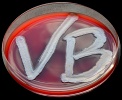| Species/Subspecies: | Campylobacter fetus subsp. fetus | |||||||||
|---|---|---|---|---|---|---|---|---|---|---|
| Category: | Motile | |||||||||
| Etymology: | Genus name: a curved rod. Species epithet: of a fruit. Subspecies epithet: see Species epithet. | |||||||||
| Significance: | [Very important] | |||||||||
| Alternative Species Name(s): | Vibrio fetus | |||||||||
| Taxonomy: | Class Campylobacteria Order Campylobacterales Family Campylobacteraceae Genus Campylobacter |
|||||||||
| Type Strain: | ATCC 27374 = CCUG 6823 A = NCTC 10842. | |||||||||
| Macromorphology (smell): | Small colorless to cream-colored colonies (about 1 mm in diameter). | |||||||||
| Micromorphology: | Curved or helical rod (0.2-0.3 x 1.5-5.0 µm). Highly motile with a corkscrew-like motion. | |||||||||
| Gram +/Gram -: | G- | |||||||||
| Metabolism: | Microaerophilic | |||||||||
| Catalase/Oxidase: | +/+ | |||||||||
| Other Enzymes: | Hippuricase - (= hippurat -), urease - | |||||||||
| Biochemical Tests: | Hydrogen sulfide (H2S) + | |||||||||
| Fermentation of carbohydrates: | Campylobacter spp. can neither ferment nor oxidize carbohydrates. | |||||||||
| Spec. Char.: | Optimal growth temperature: about 37°C. | |||||||||
| Special Media: | ||||||||||
| Disease: |
|
|||||||||
| Genome Sequence: |
|
|||||||||
| 16S rRNA Seq.: |
| |||||||||
| Taxonomy/phylogeny:
|
About 50 species have been described within in the genus Campylobacter and some of these are further divided into subspecies. This genus is closely related to the following genera: Sulfurospirillum, Arcobacter and Helcobacter. C. fetus is closely related to C.jejuni, C. hyointestinalis, C. coli and C. lari. | |||||||||
| Updated: | 2025-10-27 |
